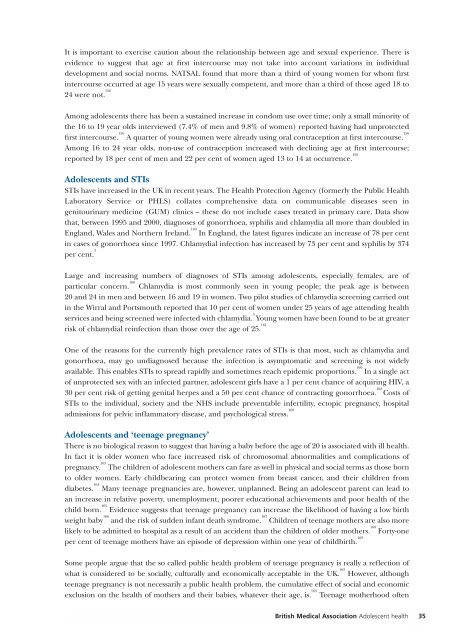Alcohol misuse: tackling the UK epidemic - London
Alcohol misuse: tackling the UK epidemic - London
Alcohol misuse: tackling the UK epidemic - London
You also want an ePaper? Increase the reach of your titles
YUMPU automatically turns print PDFs into web optimized ePapers that Google loves.
It is important to exercise caution about <strong>the</strong> relationship between age and sexual experience. There is<br />
evidence to suggest that age at first intercourse may not take into account variations in individual<br />
development and social norms. NATSAL found that more than a third of young women for whom first<br />
intercourse occurred at age 15 years were sexually competent, and more than a third of those aged 18 to<br />
24 were not. 156<br />
Among adolescents <strong>the</strong>re has been a sustained increase in condom use over time; only a small minority of<br />
<strong>the</strong> 16 to 19 year olds interviewed (7.4% of men and 9.8% of women) reported having had unprotected<br />
first intercourse. 156<br />
A quarter of young women were already using oral contraception at first intercourse. 156<br />
Among 16 to 24 year olds, non-use of contraception increased with declining age at first intercourse;<br />
reported by 18 per cent of men and 22 per cent of women aged 13 to 14 at occurrence. 156<br />
Adolescents and STIs<br />
STIs have increased in <strong>the</strong> <strong>UK</strong> in recent years. The Health Protection Agency (formerly <strong>the</strong> Public Health<br />
Laboratory Service or PHLS) collates comprehensive data on communicable diseases seen in<br />
genitourinary medicine (GUM) clinics – <strong>the</strong>se do not include cases treated in primary care. Data show<br />
that, between 1995 and 2000, diagnoses of gonorrhoea, syphilis and chlamydia all more than doubled in<br />
England, Wales and Nor<strong>the</strong>rn Ireland. 160<br />
In England, <strong>the</strong> latest figures indicate an increase of 78 per cent<br />
in cases of gonorrhoea since 1997. Chlamydial infection has increased by 73 per cent and syphilis by 374<br />
per cent. 3<br />
Large and increasing numbers of diagnoses of STIs among adolescents, especially females, are of<br />
particular concern. 160<br />
Chlamydia is most commonly seen in young people; <strong>the</strong> peak age is between<br />
20 and 24 in men and between 16 and 19 in women. Two pilot studies of chlamydia screening carried out<br />
in <strong>the</strong> Wirral and Portsmouth reported that 10 per cent of women under 25 years of age attending health<br />
services and being screened were infected with chlamydia. 3<br />
Young women have been found to be at greater<br />
risk of chlamydial reinfection than those over <strong>the</strong> age of 25. 161<br />
One of <strong>the</strong> reasons for <strong>the</strong> currently high prevalence rates of STIs is that most, such as chlamydia and<br />
gonorrhoea, may go undiagnosed because <strong>the</strong> infection is asymptomatic and screening is not widely<br />
available. This enables STIs to spread rapidly and sometimes reach <strong>epidemic</strong> proportions. 160<br />
In a single act<br />
of unprotected sex with an infected partner, adolescent girls have a 1 per cent chance of acquiring HIV, a<br />
30 per cent risk of getting genital herpes and a 50 per cent chance of contracting gonorrhoea. 162<br />
Costs of<br />
STIs to <strong>the</strong> individual, society and <strong>the</strong> NHS include preventable infertility, ectopic pregnancy, hospital<br />
admissions for pelvic inflammatory disease, and psychological stress. 160<br />
Adolescents and ‘teenage pregnancy’<br />
There is no biological reason to suggest that having a baby before <strong>the</strong> age of 20 is associated with ill health.<br />
In fact it is older women who face increased risk of chromosomal abnormalities and complications of<br />
pregnancy. 163<br />
The children of adolescent mo<strong>the</strong>rs can fare as well in physical and social terms as those born<br />
to older women. Early childbearing can protect women from breast cancer, and <strong>the</strong>ir children from<br />
diabetes. 164<br />
Many teenage pregnancies are, however, unplanned. Being an adolescent parent can lead to<br />
an increase in relative poverty, unemployment, poorer educational achievements and poor health of <strong>the</strong><br />
child born. 165<br />
Evidence suggests that teenage pregnancy can increase <strong>the</strong> likelihood of having a low birth<br />
weight baby 166<br />
and <strong>the</strong> risk of sudden infant death syndrome. 167<br />
Children of teenage mo<strong>the</strong>rs are also more<br />
likely to be admitted to hospital as a result of an accident than <strong>the</strong> children of older mo<strong>the</strong>rs. 168<br />
Forty-one<br />
per cent of teenage mo<strong>the</strong>rs have an episode of depression within one year of childbirth. 169<br />
Some people argue that <strong>the</strong> so called public health problem of teenage pregnancy is really a reflection of<br />
what is considered to be socially, culturally and economically acceptable in <strong>the</strong> <strong>UK</strong>. 163<br />
However, although<br />
teenage pregnancy is not necessarily a public health problem, <strong>the</strong> cumulative effect of social and economic<br />
exclusion on <strong>the</strong> health of mo<strong>the</strong>rs and <strong>the</strong>ir babies, whatever <strong>the</strong>ir age, is. 163<br />
Teenage mo<strong>the</strong>rhood often<br />
British Medical Association Adolescent health 35
















